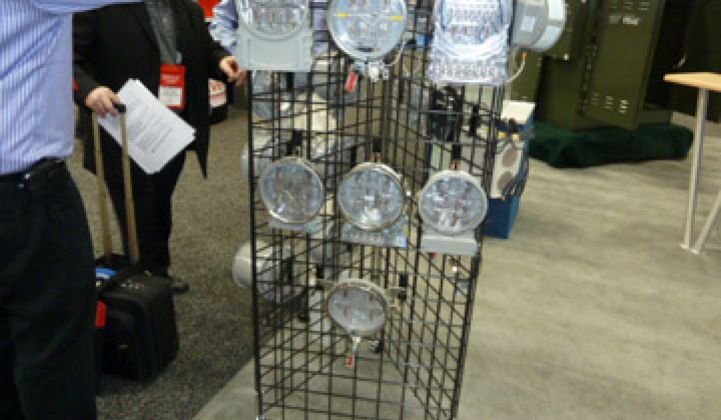San Diego -- In smart grid, all eyes are turning to the United Kingdom.
The U.K. could become a boon for smart grid vendors because of its unique electricity market, according to hallway conversations at DistribuTECH, the smart grid trade show taking place this week in San Diego.
Like much of the U.S., the U.K. is in the midst of converting its traditional electricity meters into smart meters. And like Texas, U.K. utilities do not sell power directly to consumers; instead, consumers buy it through electricity retailers.
As a result, the government would like to see a single standard for smart grid communications across the entire region. Electricity retailing would fail if consumers became locked into a provider because of the protocol attached to their meter.
Thus, many expect a single standard -- mesh, cellular, BTE, or some other proprietary standard -- or a few basic standards to get employed island-wide. The local cellular providers like BT will likely play a huge role in this, but the nation could require smart grid know-how from the States, so expect a scramble.
Late last year, EnerNoc announced it was entering the U.K., and last month General Electric bought the U.K.’s Remote Energy Monitoring. Conspiracy? Oi!
Elsewhere on the floor:
--Schneider Electric came out with a home energy monitoring solution at the show. The system includes most of the parts others include in their home systems: an internet gateway, a smart thermostat, a tabletop energy panel. As a bonus, Schneider also added in a load control device, a circuit breaker that can shut off pool pumps and/or air conditioners. (The device is actually a scaled-down version of a piece of equipment the company has made for the commercial market for years, said Schneider’s Brad Mills.)
The price? A wedgie-twisting $675. While Schneider claims the system could curb power consumption by up to 30 percent, it is still a steep price. Schneider, however, will not just market it through retailers. Utilities and demand response providers will likely be the main channel. They will offer the system to consumers at subsidized prices, as long as consumers agree to participate in peak power programs. Participate in the SuperSaver program? 80 percent off!
Thus, despite the high price, Schneider’s system could be a contender for homes. Because utilities will be a big beneficiary of these sorts of systems, consumers will expect them to foot a substantial portion of the bill. And Schneider, founded in the 1840s, is trusted by utilities.
Startups could do well here, too. Tendril CEO Adrian Tuck told us that his company won 52 of 69 of the RFPs it submitted in 2010. Still, the heft of conglomerates will make this a tough market.
--Sensus, which produces smart grid equipment that communicates on a point-to-point system, says it has a secret weapon in smart metering: water and gas. The company produces electric meters, but also meters for the other two necessities of life.
Electricity retailers that have put in a Sensus networks are working on deals to sell excess network capacity to water and gas providers. The additional fees help defray the cost of the network for the electricity utilities and water and gas companies can graduate to networking fairly inexpensively.
The base networking technology comes from its acquisition of AMDS in the 2000s. It is a proprietary standard, which is always questionable, but it delivers the performance that proprietary standards can sometimes deliver. A Sensus base station can communicate with meter five to ten miles away, and sometimes even further.
--Have you wondered why ABB has been in the news so often lately, and why a company with a Swiss-Swedish background has been acting like an American company and snapping up acquisitions with abandon?
Last year, it bought Baldor Electric (efficient motors) for $4.2 billion, virtual power plant developer Ventyx for $1 billion, and Insert Key Solutions, which specializes in asset management software. And Ventyx, as an independent subsidiary, recently bought Obvient. All of them are U.S. companies.
ABB also invested in PowerAssure, which makes software for managing applications in datacenters to save money, and Ecotality. Again, Americans.
The reason? It brought in Joe Hogan, formerly the head of GE’s medical unit, in 2008. Hogan focused the company on its two core strengths -- industrial automation and power -- and formed groups within the company to conduct acquisitions and partner with startups. The company when Hogan came in had a $7 billion war chest.
Like Siemens, GE and Schneider (the other three members of the Four Horsemen of the Smart Grid) ABB will sell the vast majority of its products to other businesses and utilities, but it is exploring ways to get closer to the consumer. Hence, the investment in car charging outfit Ecotality.
--The next big technology? Voltage management. PowerSense from Denmark, which uses optical technology to monitor voltage, is here. Earlier this week, we wrote about Petra Solar, which combines voltage monitoring and solar, and last year heard from Elster Solutions CEO Mark Munday on the topic. It’s replacing smart meters in a lot of conversations.
--And in case you were wondering, no, this is no CES with big screen TVs and cool stuff for the home. Most of the booths are just showing meters, like in the picture. Enjoy!



